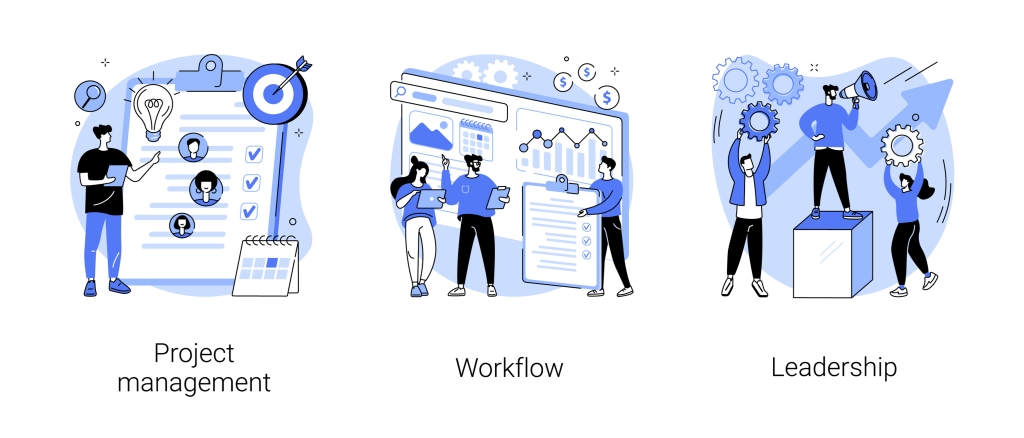Listen on Spotify.

Finding ways to maximise our personal and collective efficiency is imperative in business. That’s old news to most of us, right? But there has been a shift in focus from individual efficiency to team productivity — a shift evidenced by many companies concentrating on re-skilling employees — thus, the demand for good software to facilitate and encourage efficient teamwork grew.
Why? Well, if you’re running a small business, you have to be spending your time in more productive ways than constantly monitoring your co-workers’ activities, right? So, you need some sort of proper system in place to make keeping track of work as fast and easy as possible.
People rose to the challenge beautifully. So much so that it can now be hard to know which project management solution to go for. I know I have trouble deciding. So, I thought it’d be helpful to look into three of the frontrunners in this market and see how they may improve productivity and work performance — on both a team and individual level.
Ready to find out more?
Let’s dive in.
Notion
Notion is an all-in-one productivity tool designed to enable people to plan, write, organise and work together effectively to get more done in less time.
What can it do for you?
- It has a powerful database with a robust wiki tool.
- This means you can include many different types of content like business goals, manufacturing practices, and contact details so that you can find all of it in one place.
- Users can add a variety of other content such as lists and images. Drag and drop make sorting out the layout fast and easy.
- Updating information is also super easy.
- Notion’s tools let you manage tasks and projects like a pro.
- You can plan, track, adapt and update numerous tasks and projects from one place.
- The platform is easily accessible and highly visible. The real-time, accurate updates allow teams to work effectively from anywhere. Thereby, you can increase both team and individual productivity.
- You can communicate with ease too, anyone can post comments and start conversations. You can also use @mentions if you want to quickly gain someone’s attention.
- The intuitive UI makes it simple to manage documents.
- As well as the drag and drop feature I mentioned earlier, Notion allows you to keep tabs on all content.
- You can add keywords you want to track and thus enable effective collaboration.
- You can set deadlines to help keep to a schedule and individual users can choose to keep their notes private, publish them on the web or share them with their team members only.
Now we know more about what it can do for you, let’s take a look at the reasons you might choose notion over some of its — perhaps more popular — competitors.
The pros
- It’s user-friendly. New users can start working to create pages, use web clippings and build tables and format all the content in minutes.
- If you do get stuck, don’t worry. Notion has tutorials to help you out. If that fails, technical support is on hand and will respond to your queries.
- As Notion is a single-platform solution that has lots of tools you can use to save time. You don’t have to open lots of tabs or switch applications more often than you need to.
- If you’re after a great deal, you can get a free individual plan which allows you to have blocks of up to 5 guests and unlimited pages.
- You can use Notion across different devices. You can use it via the Windows app, the Mac app or the web-based app. You can also use the iOS or Android mobile app. You can work and share information from anywhere with ease and — by extension — boost your productivity on the go.
- Its powerful Wiki tool and other great features give teams excellent flexibility and organisation which is ideal if you want to work on relatively simple, general projects.
Next, let’s look at the limitations of Notion.
The Cons
- You need to have some time available to set Notion up, especially if you want to collaborate with others. Taking time to set it up well, will allow it to work as seamlessly as possible for everyone.
- The navigation of the platform is not the best. Improving the side bar could make it easier for you and your colleagues to go through pages. The search function could also be improved so that you can find the piece of work or page you’re looking for more easily.
- Formatting text and exporting work to another sort of document or file could be better. The UX could be improved by developing it further to allow for image and PDF annotation and encryption.
If your business needs and workflows are quite unique Notion may be just what you need. You can build tools that are as multi-layered or simple as is needed. On this platform, changes are easy to see, and all team members get real-time updates. All the tools each team member uses are accessible in one place, helping you all stay on track.

ClickUp
ClickUp is a work platform designed to help businesses of all sizes. It brings together all company information in one cloud-based online solution and combines it all with important business software.
What can it do for you?
Similar to other front-runners in this market, ClickUp allows you to assign tasks to team members and manage projects for your customers or clients and work effectively with your co-workers. It can help you increase your team productivity by helping you communicate with colleagues directly and in the proper context and generate user-ready reports in a flash.
Later, we’ll investigate the drawbacks of using ClickUp. First though, let’s look at what ClickUp does well.
The Pros
- You can use all the features and tools ClickUp offers to work in an accessible and efficient way. Multiple features are there to help you master the art of project management. For instance:
- It has time tracking capability that’s highly useful and flexible.
- Team members can collaborate well and boost individual productivity as well as their collective efficiency by adding comments to documents and receiving notifications when changes are made.
- You can make use of dashboards to get a quick overview of information.
- In the app, you can see data and work in a wide variety of layouts, views and displays. To name just a few, you can use:
- A Gantt view for schedules.
- A list view for to-dos
- Board view to visualise your workflows.
- Box view for dashboards.
- You can customize ClickUp’s software to suit your needs. You can:
- Change how you describe what stage you and your team members are at in your work.
- Modify the workspace and pick the features you want to have on hand.
- Choose your preferred colours and themes.
- The customisable nature of the software makes it very flexible and versatile. You can use it for product launches, sprint management or even bug tracking. Developers can even collaborate effectively on code and highlight syntax to improve ClickUp for all of us.
- Its fantastic for people working remotely, whether you’re flying solo or working in a team. You can set reminders to keep yourself on track. Sharing documents and being able to assign tasks on the go will supercharge your team productivity.
- There’s a free version available that lets you access many features you have to pay for if you use other project management software, such as time tracking, third-party integration and giving users access to round-the-clock support.
- Click up can replace multiple other applications used to manage different aspects of a project. Therefore, it’s cost effective.
- Its customer-focused and user-friendly, so people can have an excellent user experience.
Now let’s investigate the drawbacks of this popular application.
The Cons
- Right now, it may be said that ClickUp has an over abundance of features. The sheer variety of features on offer means that people have to get used to using it. Some have said this learning curve is a bit steep and that it’s difficult to use all of the features.
- There needs to be improvement in the user interface. Some colours do not offer strong enough contrast and if you come across empty panes or spaces it can be confusing. The text is a bit small too.
- As with the features, the number of customisation options can be a drawback as well as an advantage. It can be tricky for the average person to work out which option to choose to ensure ClickUp will run without a hitch. As there’re more options than clicking ‘done’ and ‘not done’ available when you first set it up, you do need to do a bit of thinking and planning before you start so that you can use the perfect tools and features for you.
As you can see, ClickUp’s strengths far outstrip its weaknesses. All the weaknesses I’ve highlighted are ones that can be worked on and perhaps even eliminated in time, as developers are listening and responding to feedback constantly. ClickUp is still a big player in the world of project management and is well worth a go for lone rangers and savvy team players looking for a first-class collaboration and work management solution.

Last, but by no means least, let’s explore Smartsheet.
Smartsheet
Smartsheet is an online tool invented to ease collaboration and help people achieve more on its especially designed platform, by way of its intuitive user interface. Its more than just another productivity app. What sets Smartsheet apart is the way it transforms the columns and rows of a spreadsheet into something that can be used for multiple purposes.
What can it do for you?
Here’re some of the business processes that it can be used to streamline.
- Resource management.
- Tracking tasks.
- Budgeting.
- Reporting.
You can use it to perform many more processes than you can on a more traditional project management platform. What’s more, as most are familiar with using spreadsheets, you and your colleagues won’t need too much training to get the hang of it.
The Pros
- Good collaboration. Even people who don’t have a Smartsheet account can work with the multiple features it offers to help increase their individual productivity as well as being great, helpful team members.
- Each team member can give co-collaborators real-time updates on what they’re working on, automate their own workflows and manage their tasks. Gantt charts are available to help you track tasks at a glance. There is also a first-rate card view which let’s you and your team import boards from Trello.
- Smartsheet offers users robust security and has controls that allow you to review access, usage and ownership of documents files and data.
- You can store files relevant to the project you’re working on without switching windows or exiting the app. You can also easily import, upload and share files from Word and PowerPoint as these file formats are supported.
- The reporting tools are flexible and can be focused on a number of factors, such as overdue tasks or tasks per team member, to name just two. Reports can be sent via the app’s tools and can be applied to many sheets at the same time.
- Smartsheet has a useful mobile app so that you can be productive while you’re on the go too.
The Cons
- It’s more expensive than compared to other apps of this type.
- Smartsheet has no in-built time tracking feature and relies on integrations from third parties. This fact by itself should not put you off trying Smartsheet, as lots of other project management software does the same. That being said, many people do consider the ability to keep tabs on time an essential element of building a truly productive team that has the best chance of creating super products.
- Comments and notes can be hard to follow because there’s no activity stream or communication hub. So, you can only see sheet activity when you’re on the sheet, which isn’t always enough.
- You can only see a limited number of events or tasks on the calendar view at any one time. You and your team members can’t see a full overview of their busy schedule without opening a new window.
- Some people have reported that some of their favourite Excel formulas don’t work in Smartsheet. This means you may have to learn a little more about how it works before you can use it as easily as you would Excel.
Although there’re many more popular alternatives to Smartsheet available, it remains competitive, efficient and reliable software that may still be well worth trying out.
Which would I use to help increase my productivity?
Personally, going on what I’ve been able to discover so far, I’d give ClickUp a go first. I’ve two main reasons for this.
One is you can get access to some of the best features on the free version, including time tracking, so I can work to improve my own time management. And we’ve seen before how great time management can boost your productivity.
The second is that ClickUp’s current shortcomings do look like solvable problems as long as they continue listening and responding to their users as they’re already doing.
That being said, I wouldn’t completely discount what Notion and Smartsheet have to offer. It should also be noted that those are just two competitors of ClickUp I chose to focus on for this post. There’re many other alternatives out there for you to investigate.
Summary
We’ve looked into 3 of the best-known work management solutions and unearthed a little of what they can do. I hope I’ve helped cut through a bit of the noise and given you the confidence to take the plunge. So, why wait? Try project management software today. Who knows? You could reach the stratosphere flying solo or take your team to great heights. If you’re very daring, you might even do both!

6 thoughts on “3 Giants of Project Management Software: How Can They Increase Productivity?”